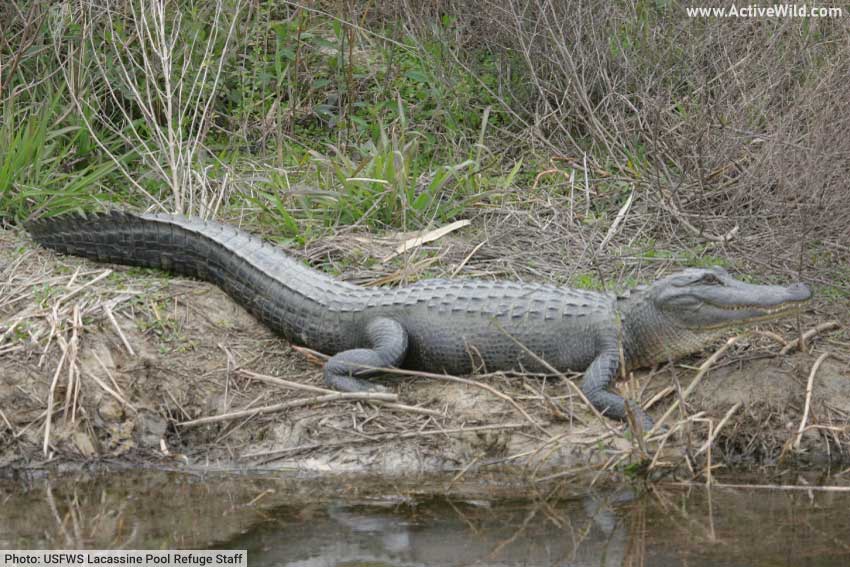
Apex Predators
Apex predators are predators with no natural predators of their own. Also known as top predators, apex predators are animals at the top of the food chain.
Examples of apex predators include mammals such as the lion, tiger, wolf, polar bear, orca and sperm whale; reptiles such as the saltwater crocodile, American alligator, king cobra and green anaconda; birds such as the bald eagle and wedge-tailed eagle, and fish such as the great white shark and great hammerhead shark.
Below is a list containing these and many other apex predators, with pictures and facts on each species. Click on the names to find information on individual species, or scroll down to browse pictures and facts on all of the animals.
Apex Predators List
- African Wild Dog
- American Alligator
- Bald Eagle
- Coconut Crab
- Cougar
- Dingo
- Fossa
- Galápagos Hawk
- Giant Moray
- Giant Otter
- Great Hammerhead
- Great Skua
- Great White Shark
- Green Anaconda
- Grizzly Bear
- Jaguar
- King Cobra
- Komodo Dragon
- Lion
- Martial Eagle
- Nile Crocodile
- Orca / Killer Whale
- Polar Bear
- Saltwater Crocodile
- Snow Leopard
- Sperm Whale
- Spotted Hyena
- Tiger
- Wedge-Tailed Eagle
- Wolf
Apex Predator Ecology
Apex predators sit at the top of the food chain and have no natural predators of their own. In ecology, apex predators are known as tertiary consumers. Below them in the food chain are the secondary consumers, which are both predators and prey of other animals. Below the secondary consumers are the primary consumers – herbivorous animals that eat nothing but plant material.
All animals – even herbivores – are consumers. Being heterotrophs, animals are unable to produce food, and therefore need to consume other organisms in order to survive.
Organisms that can produce their own food are known as autotrophs. Autotrophs such as plants, which produce their own food via photosynthesis, are the primary producers in a food chain. All other forms of life are reliant on autotrophs.
Even the mighty tiger, an apex predator that strolls through the jungles of Asia without fear of being eaten by a larger, more ferocious animal, is reliant on energy produced by plants!
Threats To Apex Predators
Although apex predators have no natural predators, they often have to deal with different kinds of threats. Because apex predators are wholly reliant on healthy ecosystems, they are often the first victims when an ecosystem changes.
Several animals in the apex predators list below are endangered. One of the primary causes is habitat loss. If an ecosystem can no longer support the required number of prey animals, its apex predators will be unable to survive. This is often highly damaging to the overall health of the ecosystem.
You can find out more about ecosystems on this page: What Is An Ecosystem?
List of Apex Predators
African Wild Dog
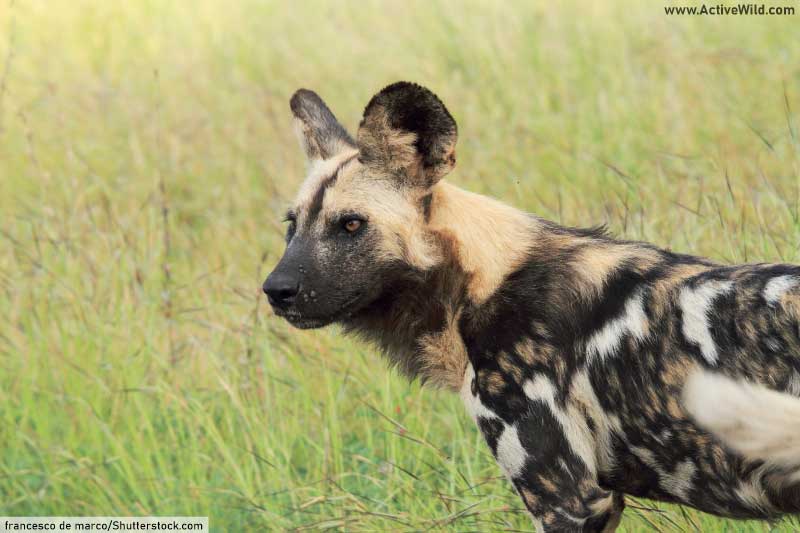
- Scientific name: Lycaon pictus
- Type of animal: Mammal
- Family: Canidae
- Where found: Africa
- Conservation status: Endangered
The African wild dog is a member of the dog family Canidae found in sub-Saharan Africa (the region south of the Sahara Desert). This apex predator can be easily recognized by its distinctive, patchy orange, black and white coat, long legs and large ears.
Although the range of the African wild dog covers much of sub-Saharan Africa, the species has an extremely low population density and is rarely seen.
A highly-social animal, the African wild dog lives and hunts in packs containing from just a handful, to over twenty, individuals. It preys mainly on antelopes, relying on its supreme endurance as it pursues its prey over large distances before the victim eventually succumbs to exhaustion.
The African wild dog requires an extremely large area in which to live and hunt. Human incursion into the dog’s natural habitat has caused the species’ range to become increasingly fragmented. These fragmented areas are unable to support the dogs in great numbers, and the species is now endangered, with a decreasing population.
Discover More with Active Wild
You can find out more about African wild dogs on this page: African Wild Dog Facts
You can see every dog species on this page: Dog Species List with Pictures & Facts
Discover more African animals on this page: African Animals List with Pictures & Facts
American Alligator

- Scientific name: Alligator mississippiensis
- Type of animal: Reptile
- Family: Alligatoridae
- Where found: North America
- Conservation status: Least Concern
The American alligator is a large reptile in the alligator family, Alligatoridae, endemic to (only found in) the southeastern United States.
The larger of the two living species of alligator (the other being the Chinese alligator), the American alligator is one of the world’s largest crocodilians, with only the saltwater and Nile crocodiles being significantly larger.
Reaching a maximum weight of around 1,000 kg / 2,200 lb., and length of 4.7 m / 15.6 ft, the American alligator is a similar size to other large crocodilians such as the Orinoco crocodile, black caiman and American crocodile.
An apex predator, the American alligator typically hunts using an ambush strategy, waiting submerged in the water for potential prey to come within range of its explosive strike. The alligator will also hunt and capture prey on land.
The American alligator has been recorded balancing sticks on its head in order to attract and capture birds collecting nesting material. This hunting strategy is one of the very few examples of tool use by reptiles.
Discover More with Active Wild
You can find out more about American alligators on this page: American Alligator Facts
You can find out more about the American crocodile on this page: American Crocodile Facts
Discover more North American reptiles on this page: North American Reptiles List with Pictures & Facts
Bald Eagle
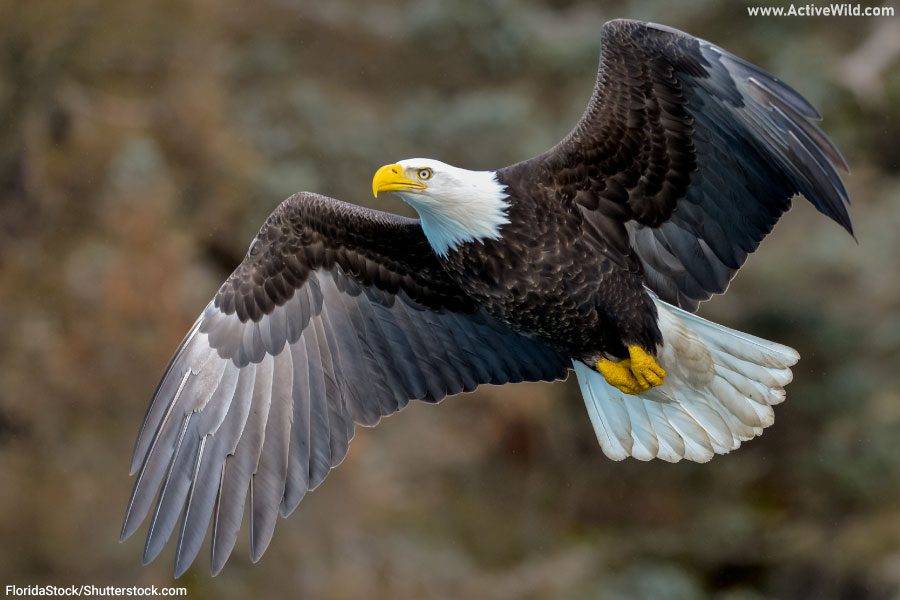
- Scientific name: Haliaeetus leucocephalus
- Type of animal: Bird
- Family: Accipitridae
- Where found: North America
- Conservation status: Least Concern
The bald eagle is the national bird of the United States of America, and one of the country’s most famous apex predators. The species is also found in Canada and Mexico.
Easily recognizable by its white head and tail, black body and wings, and yellow bill and legs, the bald eagle is usually seen in wetland habitats both by the coast and inland.
A member of the genus Haliaeetus, a group known as the “sea eagles” or “fish eagles”, the bald eagle primarily feeds on fish, but will also regularly take waterbirds and mammals. Carrion also forms a significant part of the eagle’s diet.
The use of DDT – a pesticide that causes eggshell thinning – and persecution by humans caused a dramatic decrease in the bald eagle population, with only 412 nesting pairs recorded in the contiguous states in the mid-20th century.
With the banning of the use of DDT in the United States in 1972, and numerous other conservation measures in place, the bald eagle population has rebounded, and today the species is no longer considered threatened.
Discover More with Active Wild
You can find out more about bald eagles on this page: Bald Eagle Facts
Test your knowledge of North American birds with this free app: North American Bird ID Quiz
Discover more about birds on this page: Birds – The Ultimate Guide
Coconut Crab
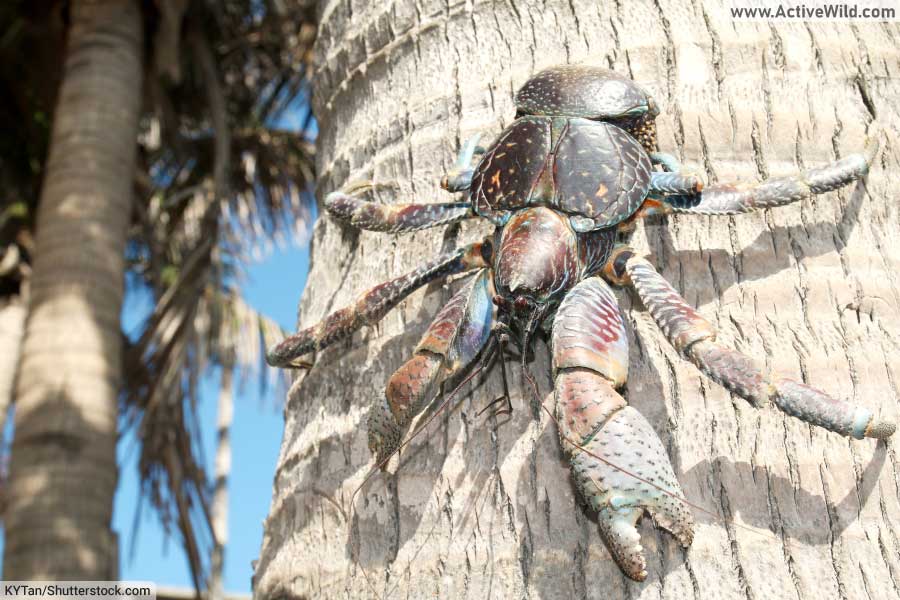
- Scientific name: Birgus latro
- Type of animal: Crustacean
- Family: Coenobitidae
- Where found: Indian Ocean, Pacific Ocean
- Conservation status: Vulnerable
Found on numerous islands in the Indian and Pacific Oceans, the coconut crab is unusual among crabs for being largely terrestrial (land-living). It is often found several miles from the shore.
The coconut crab is the world’s largest land-living arthropod, with a leg-span approaching 1 meter / 3.28 ft.
The coconut is a hermit crab, and as a juvenile, will protect its body in the discarded shells of gastropods. As an adult, its own exoskeleton hardens and additional protection is no longer necessary.
The coconut crab is an omnivore. Plant material forms the bulk of its diet, but the crustacean will also eat carrion and hunt turtle hatchlings, other crabs and even small mammals.
The adult coconut crab has no known natural predators other than man, making this large crustacean an apex predator.
Discover More with Active Wild
You can find out more about crustaceans on this page: Crustaceans – The Ultimate Guide
You can see more amazing ocean animals on this page: Ocean Animals Pictures & Facts
Cougar
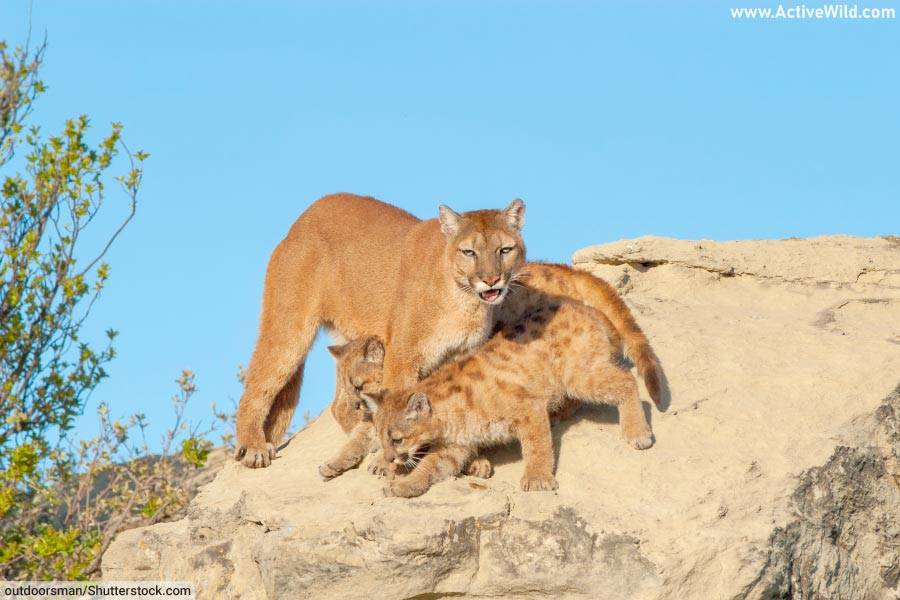
- Scientific name: Puma concolor
- Type of animal: Mammal
- Family: Felidae
- Where found: North America, South America
- Conservation status: Least Concern
With a nose to tail length of up to 2.75 m / 9 ft, and a weight of up to 100 kg / 220 lb., the cougar is the second-largest cat species of the Americas; only the jaguar is larger.
The cougar is not considered to be a “true” big cat, despite being larger on average than both the leopard and the snow leopard. This is because it does not belong to the genus Panthera., and in fact is more closely related to a house cat than it is to lions, tigers and leopards, and other “big cats”.
The cougar is known by several other names, including “puma”, “mountain lion” and “catamount”. It is found from Canada to Chile, and has the largest range of any mammal in the Americas. It is found in a wide variety of habitats, from deserts to thick forests.
Like all cats, the cougar is an obligate carnivore; only meat can provide the nutrients it needs to survive. In North America, deer make up the majority of the cat’s diet.
Although a cougar may be driven from its prey by a determined black bear or pack of wolves, it has no true predators and is therefore an apex predator.
Discover More with Active Wild
You can find out more about cougars on this page: Cougar Facts
Discover every wild cat found in North America on this page: Wild Cats Of North America
You can see every wild cat species in the world on this page: Wild Cat Species Pictures & Facts
Dingo
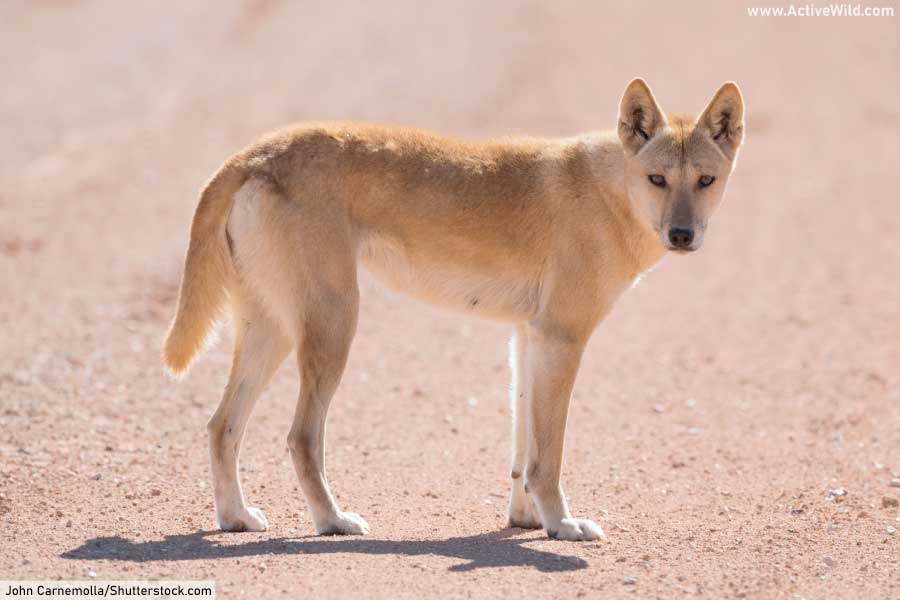
- Scientific name: Canis lupus dingo / Canis familiaris / Canis dingo
- Type of animal: Mammal
- Family: Canidae
- Where found: Australia
- Conservation status: Unassessed as species
The dingo is a medium to large dog found throughout much of Australia, in habitats as varied as deserts and tropical forests. It has a distinctive sandy-gold coat, and its bark is quite different to that of a domestic dog, with howls and growls being used more often than barks.
Thought to have originated in Southeast Asia, the dingo’s classification is debated by zoologists, with some considering it to be a subspecies of wolf, others considering it as a subspecies of domestic dog, and others considering it to be a separate species in its own right.
The dingo is closely related to the New Zealand singing dog, and may have been brought to Australia by nomadic humans at some point between 4,000 and 9,000 years ago.
The dingo either lives alone or in small family groups containing a mated pair and their offspring.
When hunting alone, the dingo typically targets smaller prey, such as possums, wombats, wallabies and rabbits. It is more likely to target larger prey, such as large kangaroos, when hunting in a pack, harassing the prey to exhaustion before moving in for the kill.
Discover More with Active Wild
You can find out more about dingos on this page: Dingo Facts
You can see every dog species on this page: Dog Species List with Pictures & Facts
Discover more amazing Australian animals on this page: Australian Animals Pictures & Facts
Fossa
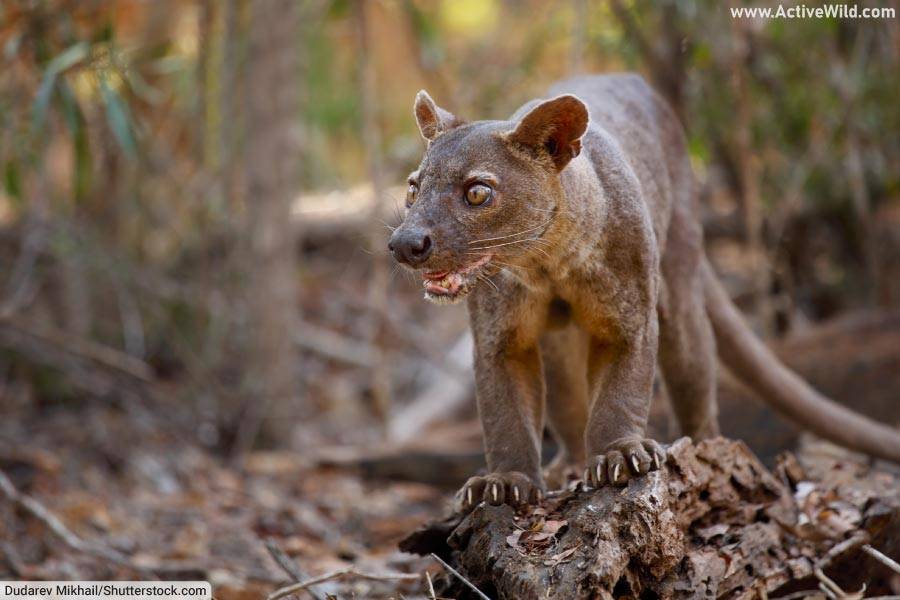
- Scientific name: Cryptoprocta Ferox
- Type of animal: Mammal
- Family: Eupleridae
- Where found: Madagascar
- Conservation status: Vulnerable
The fossa is an apex predator found on Madagascar. It is the African island country’s largest mammalian predator.
With semi-retractable claws, and flexible ankles that allow it to climb head-first down tree trunks, the fossa is perfectly equipped for hunting on land and in trees. Lemurs make up for more than half of its diet, but it will also feed on a variety of small vertebrates.
Although crepuscular activity is not uncommon, this carnivorous mammal prefers to hunt at night, when it is perfectly camouflaged by its thick dark coat. The fossa’s fur is usually dark brown, but some individuals are black.
The only predators of the fossa are humans, who hunt the animal both for its meat and also due to the belief that the animal is dangerous. This is far from being true as this carnivore is very cautious and will avoid humans as much as it can. The fossa will sometimes prey on poultry, but this is not very common and is directly related to encroachment due to human development.
Discover More with Active Wild
You can find out more about fossas on this page: Fossa Facts
Discover more African animals on this page: African Animals List with Pictures & Facts
Galápagos Hawk
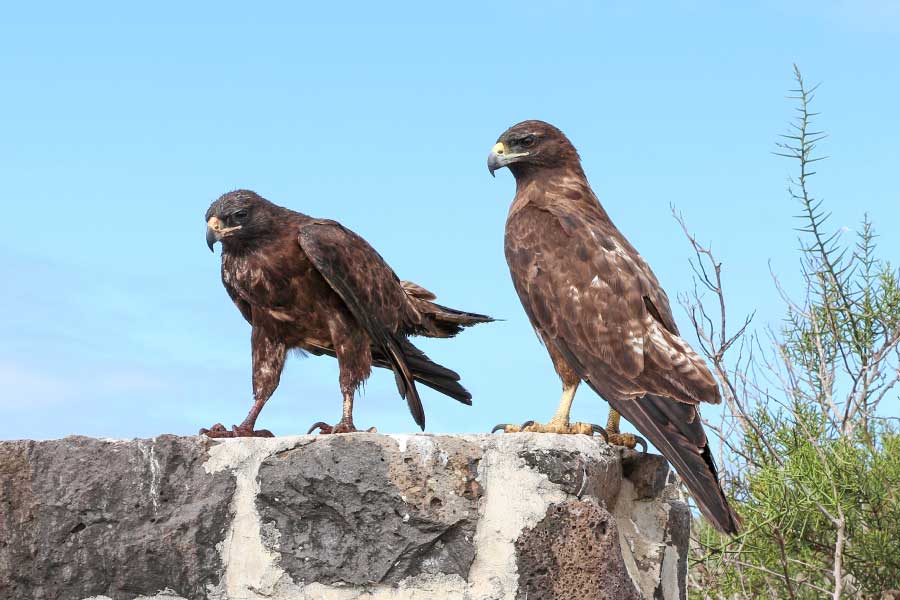
- Scientific name: Buteo galapagoensis
- Type of animal: Bird
- Family: Accipitridae
- Where found: Galápagos
- Conservation status: Vulnerable
The Galápagos hawk is at the top of the food chain throughout its range on the Galápagos islands, where it feeds on most small to medium sized vertebrates and invertebrates found in the area. It will also eat carrion when available.
This bird lives and hunts in small family groups of 2 – 3 individuals, using its impressive eyesight to spot prey as far as 30.5 m / 100 feet away while soaring the sky.
The Galápagos hawk is perfectly equipped for hunting as it has strong, sharp talons to catch and kill its prey and a tough, curved beak that allows it to rip off pieces of meat.
The male Galápagos hawk is monogamous while the female can mate with up to 7 different males during the breeding season. The female and the males all help incubate the eggs and care for the young.
Discover More with Active Wild
Discover more about birds on this page: Birds – The Ultimate Guide
You can find out more about the different types of birds on this page: Types Of Birds Pictures & Facts
Giant Moray
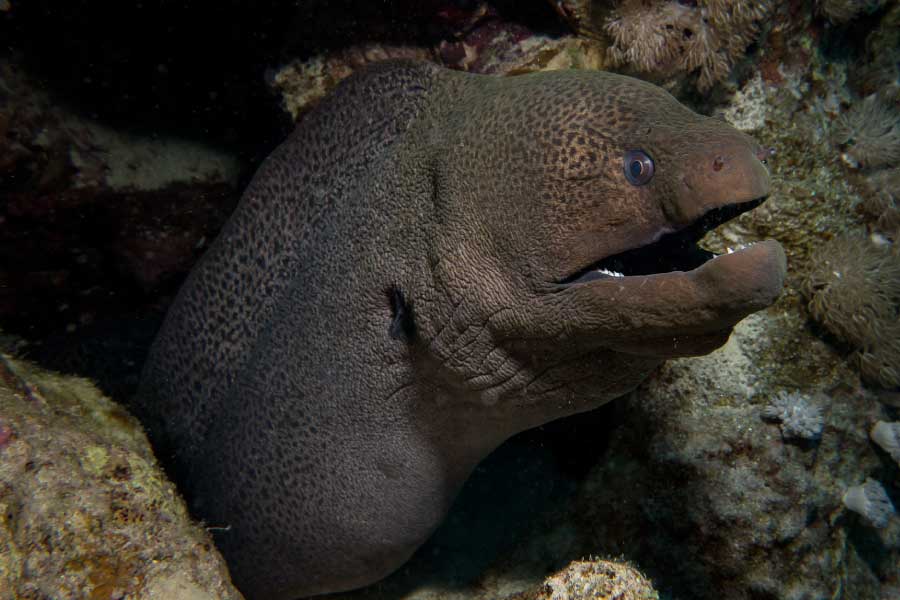
- Scientific name: Gymnothorax javanicus
- Type of animal: Fish
- Family: Muraenidae
- Where found: Indian ocean, Pacific ocean
- Conservation status: Least Concern
The giant moray is a large carnivorous eel with an average length of 3 m / 9.8 feet and a weight of 24 kg / 53 lbs. The largest giant moray recorded weighed an impressive 70 kg / 154 lbs.
Although the species is the largest moray eel in terms of weight, the slender giant moray Strophidon sathete is longer.
The giant moray has two pairs of tubular nostrils, and makes up for its poor eyesight with its extraordinary sense of smell. This makes the eel an efficient nocturnal predator.
The giant moray has a symbiotic relationship with shrimp that will clean its teeth and rid it of external parasites in exchange for food scraps. (Fish known as cleaner wrasse also perform this service.)
The giant moray has both sharp and curved teeth that are perfect for holding its prey in place and tearing the flesh. Most of its diet is made up of fish but it will also prey on crustaceans.
Discover More with Active Wild
Become a fish expert: Fish – The Ultimate Guide To Fishes & Fish Life
Discover more amazing fish on this page: Types of Fish with Pictures & Facts
You can see more amazing ocean animals on this page: Ocean Animals Pictures & Facts
Giant Otter
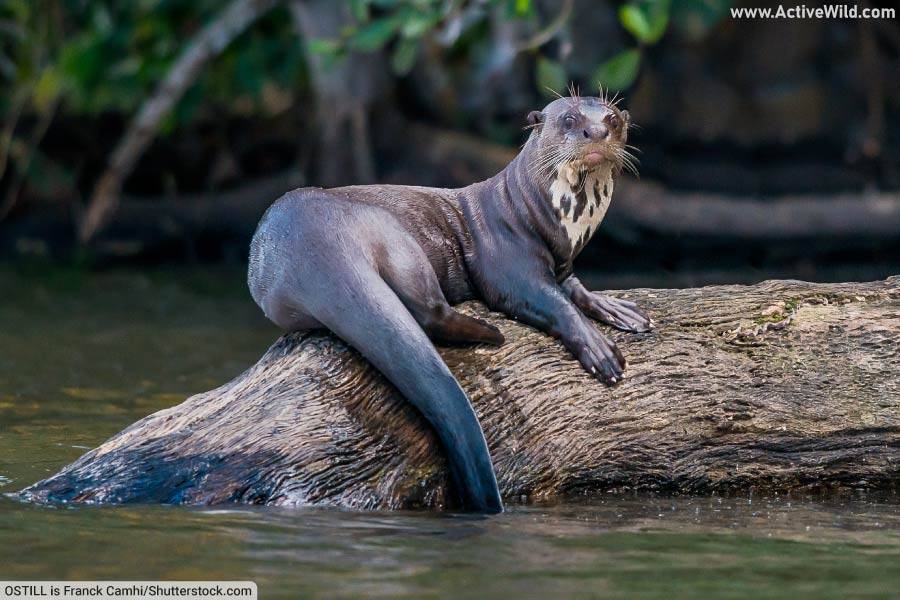
- Scientific name: Pteronura brasiliensis
- Type of animal: Mammal
- Family: Mustelidae
- Where found: South America
- Conservation status: Endangered
The giant otter can reach a length of 1.8 m / 6 feet and a weight of 34 kg / 75 lbs., making it the largest member of the Mustelidae family.
All senses are employed when hunting, but the giant river otter’s eyesight is particularly important and highly specialized for providing acute vision in the murky river water.
The giant otter needs to be an efficient hunter as it requires 1.7 – 4.1 kg / 6 – 9 lbs. of fish per day. To accomplish this, it will hunt both solo and as a group displaying coordinated strategies.
While fish make up the bulk of the giant otter’s diet, it will also eat crustaceans, reptiles and other small vertebrates.
The giant otter is endemic to South America, where it prefers to live in slow flowing rivers with abundant vegetation. The species is present in the Amazon Rainforest.
Discover More with Active Wild
You can see more rainforest animals on this page: Rainforest Animals List with Pictures & Facts
Become a mammal expert: Mammal Facts
Discover more amazing mammals: List of Mammals with Pictures & Facts
Great Hammerhead
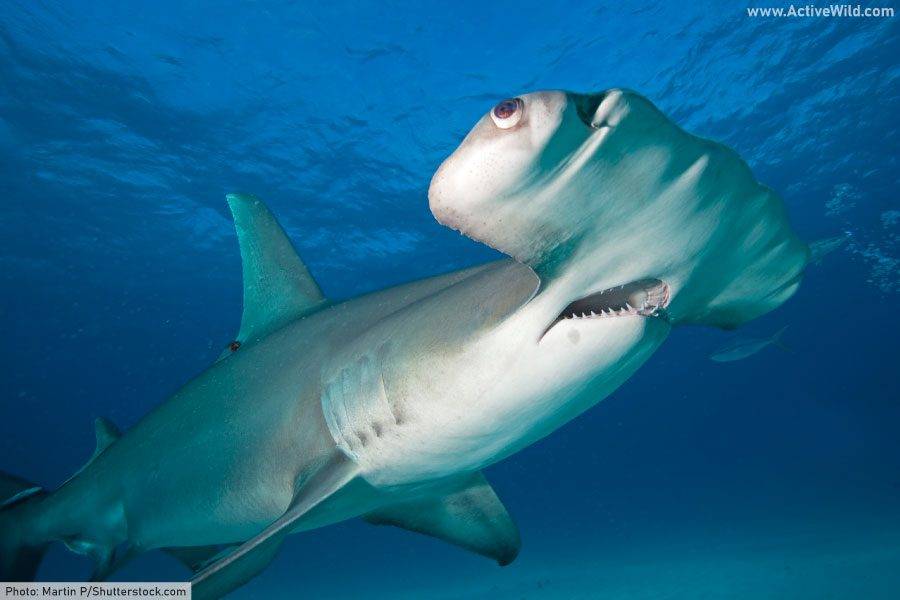
- Scientific name: Sphyrna mokarran
- Type of animal: Fish
- Family: Sphyrnidae
- Where found: Oceans worldwide
- Conservation status: Critically Endangered
The great hammerhead is the largest of all hammerhead shark species, reaching a length of 6.1 m / 20 feet.
The most remarkable feature of this ocean apex predator is its head, the elongated shape of which is believed to serve several purposes. The wide-set eyes provide the shark with excellent binocular vision, and the widely-spaced nostrils are thought to help the shark better locate the direction from which a scent is coming.
The elongated head is also able to accommodate more of the electroreceptive organs with which sharks detect electrical fields produced by other sea animals.
The great hammerhead shark is immune to the venom found in stingrays, and the rays are a regular part of its diet. It also feeds on squid and smaller species of shark.
Although the great hammerhead often gathers in large groups, it is a solitary nocturnal hunter.
The main threat to this critically endangered shark is overhunting by humans, who target the fish for its teeth, fins and skin.
Discover More with Active Wild
You can find out more about great hammerheads on this page: Great Hammerhead Facts
You can see more sharks on this page: Types of Sharks – Pictures & Facts
You can see more amazing ocean animals on this page: Ocean Animals Pictures & Facts
Great Skua
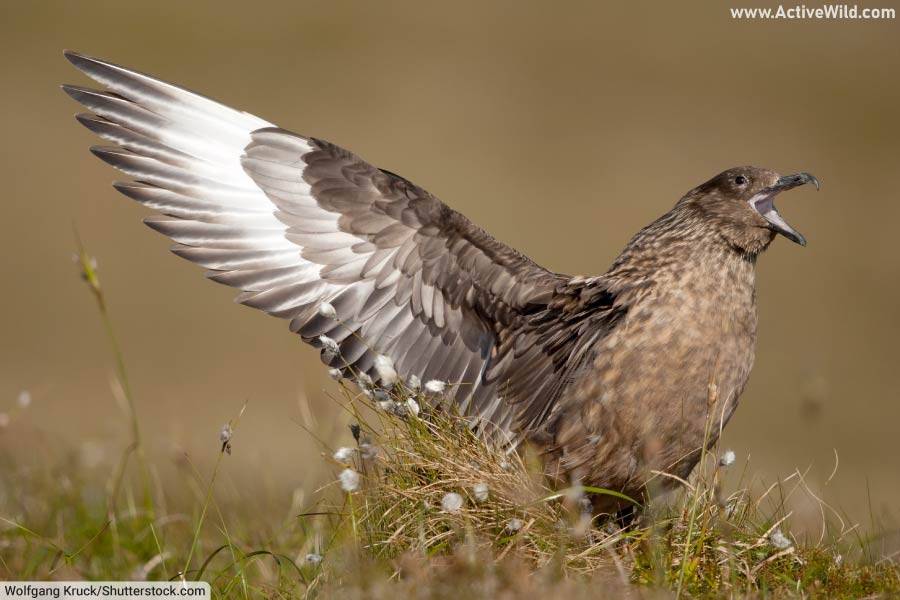
- Scientific name: Stercorarius skua
- Type of animal: Bird
- Family: Stercorariidae
- Where found: All Continents
- Conservation status: Least Concern
The great skua is a large, aggressive sea bird that spends most of its life at sea, settling on land only during the breeding season. It shows no fear of humans and will violently defend its nest from any intruder.
This bird’s feathers are dark brown with lighter stripes. Its beak and feet are dark gray. The great skua has webbed feet so is limited to using its strong, curved beak to hunt.
This carnivorous bird feeds mainly on fish but is an opportunistic hunter that will eat a variety of other animals. It is known to chase other sea birds, including some that are considerably larger than it, and steal their prey. Smaller sea birds are also a regular part of the great skua’s diet, as is carrion.
The great skua is a remarkable predator that, unusually, has been recorded hunting for petrels at night.
Discover More with Active Wild
Discover more about birds on this page: Birds – The Ultimate Guide
You can find out more about the different types of birds on this page: Types Of Birds Pictures & Facts
Great White Shark

- Scientific name: Carcharodon carcharias
- Type of animal: Fish
- Family: Lamnidae
- Where found: Oceans worldwide
- Conservation status: Vulnerable
The great white shark is the largest member of the Lamnidae family, reaching a length of 8 m / 26.2 feet and a weight of over 2 tons / 4409.3 lbs.
Although the great white shark is an apex predator, its population is highly vulnerable to human impact due to its low productivity. It takes the male 26 years to reach sexual maturity and the female 33. Females will give birth to a litter of 2 – 10 pups every two years.
The adult great white shark is opportunistic and will feed on sea lions, dolphins, various species of seals, sea birds and even turtles and dead whales.
This shark has around 300 teeth, each of which is around 6 cm / 2.4 in. in length. The teeth are arranged in several rows, with replacements always ready if one of the front teeth breaks off. The teeth are serrated, giving the shark a powerful, cutting bite.
Discover More with Active Wild
You can find out more about great white sharks on this page: Great White Shark Facts
You can see more sharks on this page: Types of Sharks – Pictures & Facts
You can see more amazing ocean animals on this page: Ocean Animals Pictures & Facts
Green Anaconda
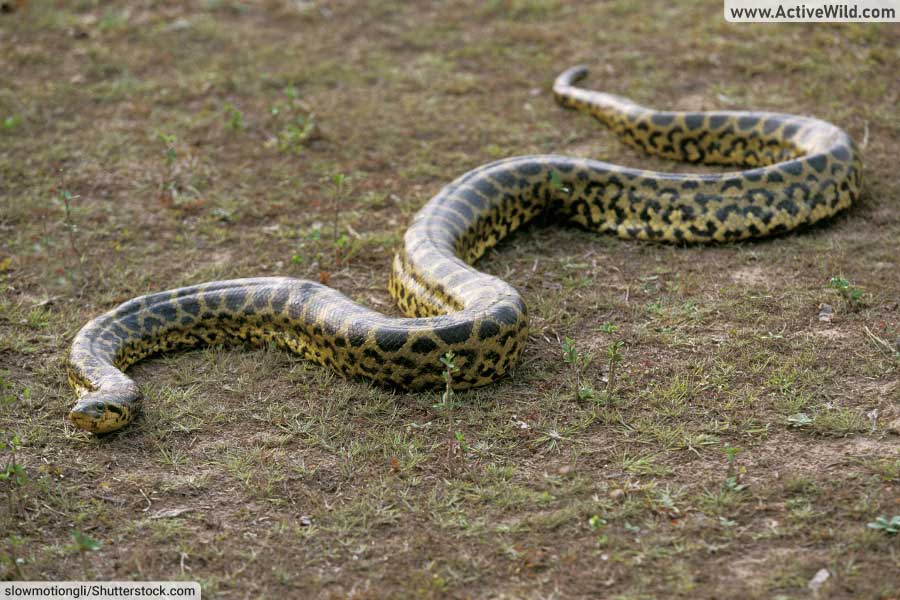
- Scientific name: Eunectes murinus
- Type of animal: Reptile
- Family: Boidae
- Where found: South America
- Conservation status: Least Concern
The green anaconda is the world’s largest snake species in terms of weight, but is exceeded in length by the reticulated python. The green anaconda reaches a length of 10 – 12 m / 32.8 – 39.4 feet and a weight of up to 250 kg / 551 lbs. It exhibits sexual dimorphism, with females larger than males.
This semiaquatic constrictor snake ambushes its prey by staying hidden underwater, close to the water’s edge, from where it will strike out to catch the unsuspecting victim. The green anaconda will feed on almost anything it can catch, including deer, jaguars, large rodents, fish, turtles, birds, and caimans.
Due to its slow metabolism, the green anaconda can go several months without food after a large meal. There have been reports of anacondas trying to swallow meals large enough to cause serious injury or even death.
The green anaconda tends to be solitary and will only socialize during breeding season.
Discover More with Active Wild
You can find out more about green anacondas on this page: Green Anaconda Facts
Discover more about the world of snakes: Snake Facts
You can see more amazing snakes on this page: Types of Snakes
You can find out more about reptiles on this page: Reptiles – The Ultimate Guide
Grizzly Bear
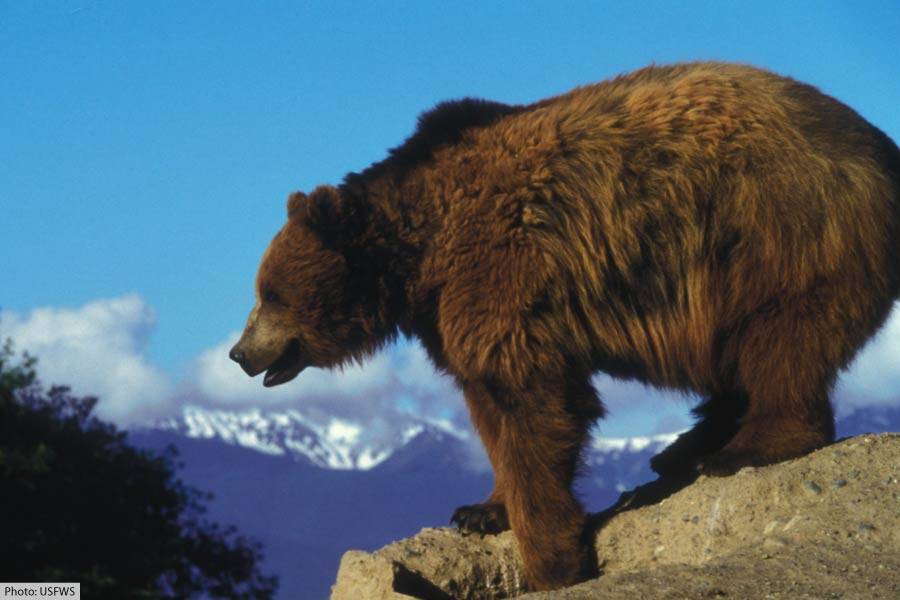
- Scientific name: Ursus arctos horribilis
- Type of animal: Mammal
- Family: Ursidae
- Where found: North America
- Conservation status (brown bear): Least Concern
The grizzly bear is a massive sub species of the brown bear (Ursus arctos) that is found throughout western United States and Canada.
The male grizzly can reach a height of up to 3 m / 9.8 feet and a weight of more than 300 kg / 661 lbs. The female is smaller, with an average weight of 160 kg / 353 lbs.
The grizzly bear is omnivorous, feeding on berries, insects, mushrooms, roots and small rodents, as well as large animals such as moose and elk.
Surprisingly agile for its size and bulk, the grizzly bear can reach a speed of 56 km / 35 miles per hour when running. Its large, curved, strong claws are excellent tools for digging when the bear is foraging for food.
This bear has an outstanding sense of smell that is calculated to be seven times stronger than that of a bloodhound. This makes up for the bear’s poor eyesight.
Discover More with Active Wild
You can find out more about grizzly bears on this page: Grizzly Bear Facts
Discover more about bears on this page: Bears – The Ultimate Guide
You can see more iconic North American animals on this page: North American Animals Pictures & Facts
Jaguar

- Scientific name: Panthera onca
- Type of animal: Mammal
- Family: Felidae
- Where found: South America, North America
- Conservation status: Near Threatened
The jaguar is the largest cat species found in the Americas and the third-largest in the world, after the tiger and lion. It has a tan/yellow coat that is marked with numerous black rosettes (which, unlike those of a leopard, have black centers). The jaguar’s coat provides perfect camouflage when it is stalking prey.
The bite force of this apex predator is the most powerful of all cat species, with a strength calculated at 1034 n/cm2 / 1500 psi.
The jaguar is a solitary animal that is most active at dawn and dusk. It will usually stay close to bodies of water and is an excellent swimmer.
As all other cat species, the jaguar is a true carnivore. Most of its diet is made up by medium to large mammals such as capybaras, tapirs and deer but it will eat most animals it can catch, including snakes and caimans.
Discover More with Active Wild
You can find out more about jaguars on this page: Jaguar Facts
You can see every wild cat species in the world on this page: Wild Cat Species Pictures & Facts
Discover more amazing rainforest animals on this page: Rainforest Animals List with Pictures & Facts
King Cobra
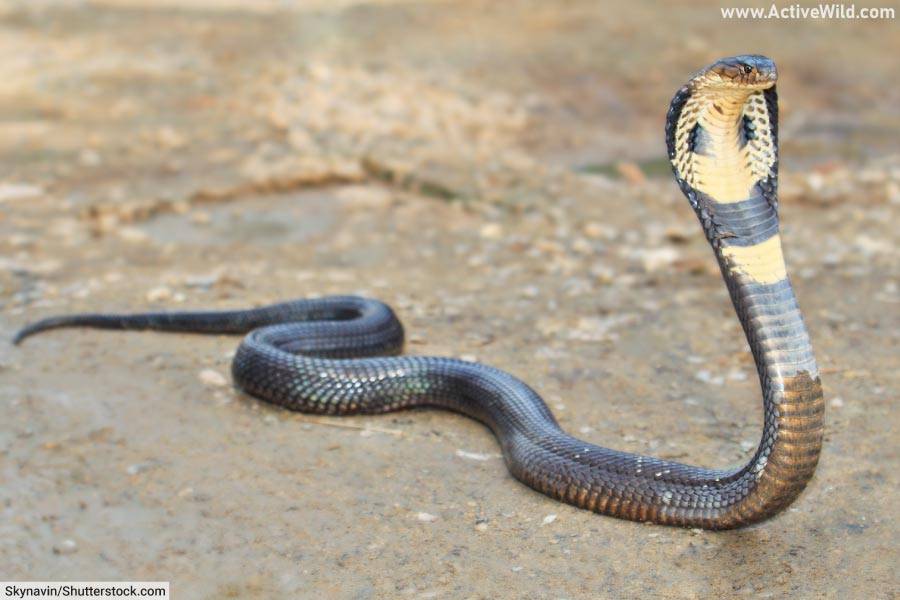
- Scientific name: Ophiophagus hannah
- Type of animal: Reptile
- Family: Elapidae
- Where found: Asia
- Conservation status: Vulnerable
The king cobra is the longest venomous snake in the world, with an average length 3.7 m / 12 feet and a maximum length of 5.5 m / 18 feet. An adult king cobra is a top predator whose only threat is from humans.
This Asian carnivore is very particular about its diet as it preys, almost exclusively, on other cold-blooded animals, especially other snake species.
The king cobra is the only snake in the world that builds a nest for its eggs. The female will guard the nest until the eggs hatch; after that the hatchlings are on their own.
The king cobra’s venom is so powerful that a single bite can kill an adult elephant within a few hours.
Discover More with Active Wild
Discover more about snakes on this page: Snake Facts
See different types of snakes on this page: Types of Snakes
You can find out more about reptiles on this page: Reptiles – The Ultimate Guide
Komodo Dragon
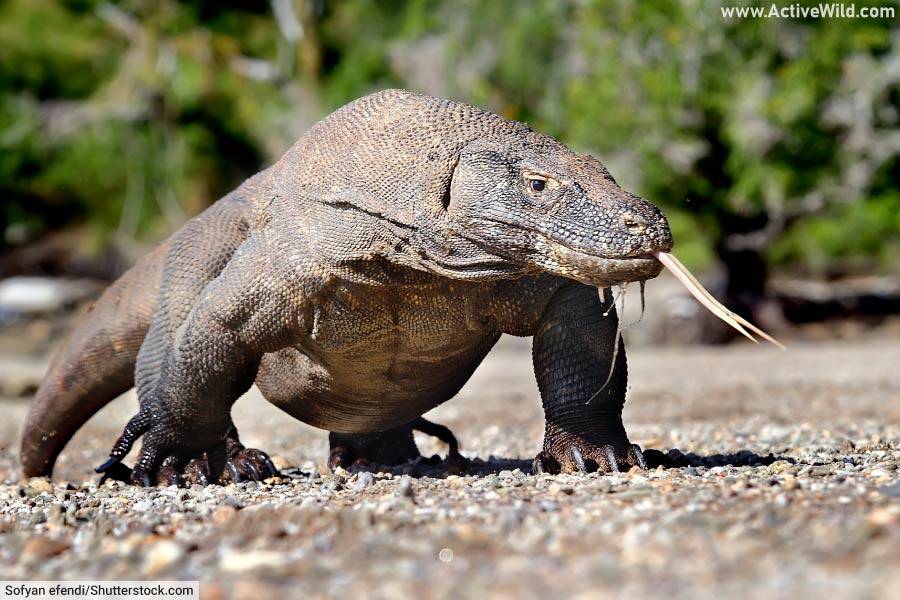
- Scientific name: Varanus komodoensis
- Type of animal: Reptile
- Family: Varanidae
- Where found: Asia
- Conservation status: Endangered
The Komodo dragon is the largest lizard in the world, easily reaching lengths of over 3 m / 9.8 feet and a weight of 165 kg / 364 lbs.
A carnivore, the Komodo dragon feeds mainly on carrion, but it will also kill and eat prey much larger than itself.
When hunting, the Komodo dragon uses an ambush strategy, waiting for an animal to come close before pouncing, then following the prey until it succumbs either from blood loss, due to the lizard’s anti-clotting venom, or infection, due to the abundant bacteria on the Komodo dragon’s teeth.
The Komodo dragon’s teeth are sharp and have serrated edges that are great for ripping off pieces of meat, but not for chewing. This lizard will bite chunks of flesh from its prey by holding it in its mouth and forcefully shaking its head, it will then swallow the pieces whole and regurgitate anything it can’t digest.
Discover More with Active Wild
You can find out more about Komodo dragons on this page: Komodo Dragon Facts
You can discover more amazing lizards on this page: Types of Lizards – Pictures & Facts
You can see more Asian animals on this page: Asian Animals Pictures & Facts
Lion

- Scientific name: Panthera leo
- Type of animal: Mammal
- Family: Felidae
- Where found: Africa, Asia
- Conservation status: Vulnerable
The lion is the second largest felid (member of the cat family) in the world (the largest is the tiger), and the only one of the large cats that is not solitary. The lion lives in social groups called “prides” that follow a hierarchical and social order.
Due to the amount of energy that is spent hunting and digesting large prey, a lion may spend 20 to 21 hours a day sleeping.
Although the male lion will be the most aggressive during feeding time, the lionesses play a major role in the hunt. The lion’s preferred prey items are medium sized ungulates, but it will also eat carrion and steal food from hyenas and leopards.
Most of the world’s lions live in Africa, but there is a small population of around 650 lions that live in a small area in India’s Gir Forest. These Asiatic lions are slightly smaller than their African cousins.
Discover More with Active Wild
You can find out more about lions on this page: Lion Facts
You can see every wild cat species in the world on this page: Wild Cat Species Pictures & Facts
Discover more African animals on this page: African Animals List with Pictures & Facts
Martial Eagle

- Scientific name: Polemaetus bellicosus
- Type of animal: Bird
- Family: Accipitridae
- Where found: Africa
- Conservation status: Endangered
The martial eagle is the largest of the African birds of prey with a height of around 90 cm / 3 feet, and a weight of up to 6.5 kg / 14 lbs. Its plumage is mostly brown with white underparts covered in brown spots.
This eagle has a wingspan of 2.6 m / 8.5 feet which allows it to soar high enough to be invisible to the naked human eye. Its incredible eyesight allows it to spot prey as far as 5 km / 3 miles away.
To hunt, the martial eagle will plunge towards its victim at great speeds, catching and killing the prey with its sharp hind claws. It will regularly kill and eat animals much larger than itself, such as monkeys, goats and small antelopes.
The martial eagle forms monogamous pairs; it is a very territorial species and bonded pairs have a home range of around 130 km2 / 50 square miles.
Discover More with Active Wild
Discover more about birds on this page: Birds – The Ultimate Guide
You can find out more about the different types of birds on this page: Types Of Birds Pictures & Facts
Discover more African animals on this page: African Animals List with Pictures & Facts
Nile Crocodile
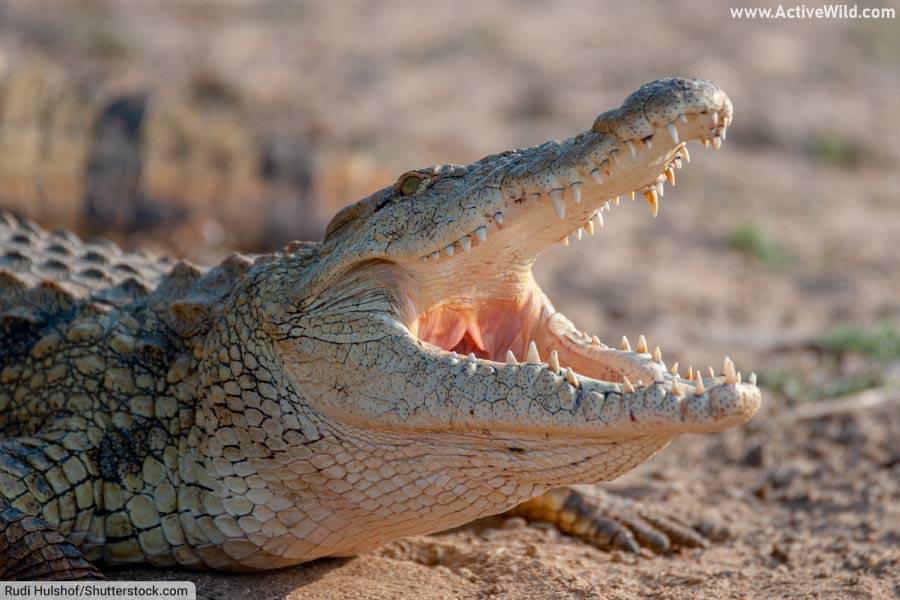
- Scientific name: Crocodylus niloticus
- Type of animal: Reptile
- Family: Crocodylidae
- Where found: Africa
- Conservation status: Least Concern
The Nile crocodile is the largest of all species of African crocodiles and the second largest crocodile in the world (only the saltwater crocodile is larger). It can reach lengths of around 5.5 m / 18 feet and weigh more than a ton / 2205 lbs.! However, a weight of about 750 kg / 1654 lb. is the average.
This African apex predator has remarkably powerful jaws that can deliver a bite with a force of 3447 n/cm2 / 5000 psi; about 5 times stronger than a lion’s bite.
The Nile crocodile is an ambush predator that usually hunts by remaining very still underwater while close to the shore and darting outwards to catch unsuspecting prey such as a zebra or antelope that bends down for a drink.
This species displays an unusual reproductive strategy (for reptiles), as it is one of the few species that not only guards the nest, but that exhibits parental care, with the female staying with the hatchlings for 2 months.
Discover More with Active Wild
You can find out more about Nile crocodiles on this page: Nile Crocodile Facts
You can find out more about reptiles on this page: Reptiles – The Ultimate Guide
See more examples of reptiles on this page: Types of Reptiles With Pictures & Facts
Orca / Killer Whale
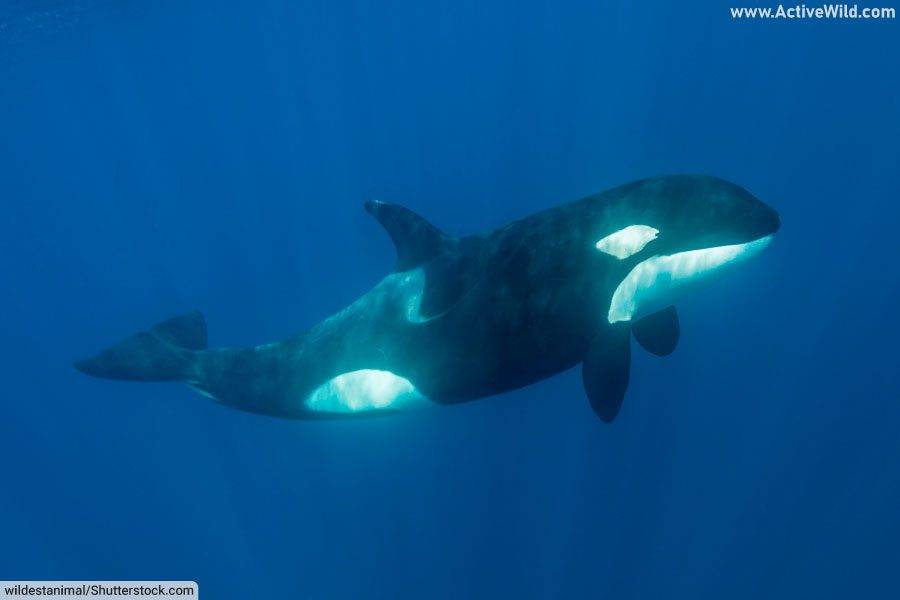
- Scientific name: Orcinus orca
- Type of animal: Mammal
- Family: Delphinidae
- Where found: Oceans worldwide
- Conservation status: Data Deficient
The orca is the largest member of the dolphin family, Delphinidae, and it is very easy to recognize due to its characteristic black and white markings. It is the most widely-distributed cetacean, inhabiting all of the world’s oceans.
Like all dolphins, the orca belongs to a group of cetaceans known as “toothed whales”. (The other main group of cetaceans are the baleen whales, which lack teeth and instead feed by filtering small items from the water with comb-like baleen plates.)
The orca is an apex predator that will hunt animals much larger than itself, including whales, often using coordinated strategies involving a pod of up to 40 individuals.
The orca has good eyesight but relies mostly on echolocation when hunting. It is an efficient predator with a high success rate, eating around 136 kg / 300 lbs. of food per day.
This cetacean has a maximum lifespan of 90 years for the female and 60 years for the male. Its average lifespan is closer to 50 years.
Discover More with Active Wild
You can find out more about orcas on this page: Orca Facts
You can see more amazing ocean animals on this page: Ocean Animals Pictures & Facts
Discover more about whales on this page: Are Whales Mammals?
Polar Bear

- Scientific name: Ursus maritimus
- Type of animal: Mammal
- Family: Ursidae
- Where found: North America, Europe, Asia
- Conservation status: Vulnerable
The polar bear is easily recognized by its massive size and white fur. In fact, the bear’s “white” fur is actually clear and hollow, making it appear white when light passes through the hairs.
This bear is considered a marine mammal due to the large amount of time it spends in the water. It is an extremely agile hunter, both on land and underwater.
The polar bear is the top predator of the Arctic region, feeding mainly on seals and other pinnipeds. The fatty flesh of these animals allows the bear to meet its high calorific requirements and maintain its own insulating fat layer.
The polar bear serves a very important role in the Arctic ecosystem by inadvertently providing food for weak or inexperienced bears, as well as other animals such as the Arctic fox, as it usually eats just the skin and blubber of its kill, leaving behind the unconsumed meat.
Discover More with Active Wild
You can find out more about polar bears on this page: Polar Bear Facts
Discover more about bears on this page: Bears – The Ultimate Guide
You can see more Arctic animals on this page: Arctic Animals List with Pictures & Facts
Saltwater Crocodile

- Scientific name: Crocodylus porosus
- Type of animal: Reptile
- Family: Crocodylidae
- Where found: Australia and Asia
- Conservation status: Least Concern
The saltwater crocodile is both the world’s largest crocodilian, and the world’s largest reptile.
The male is larger than the female and can reach a length of 7 m / 23 feet. It has between 64 and 68 teeth that are 13 cm / 5 in. long each, and it has the greatest bite pressure of any animal in the world.
The saltwater crocodile (known informally as a “saltie”) is an opportunistic feeder, eating almost anything it can catch (including humans!).
This large crocodilian is an apex predator whose only threat, once it has reached a certain size, is humans, who hunt it for its meat, eggs and skin. There are several conservation programs currently in place to ensure the protection of the species.
The saltwater crocodile is considered one of the smartest reptiles and even has a few distinct calls it uses to communicate with conspecifics.
Discover More with Active Wild
You can find out more about saltwater crocodiles on this page: Saltwater Crocodile Facts
Discover more amazing Australian animals on this page: Australian Animals Pictures & Facts
You can find out more about reptiles on this page: Reptiles – The Ultimate Guide
Snow Leopard
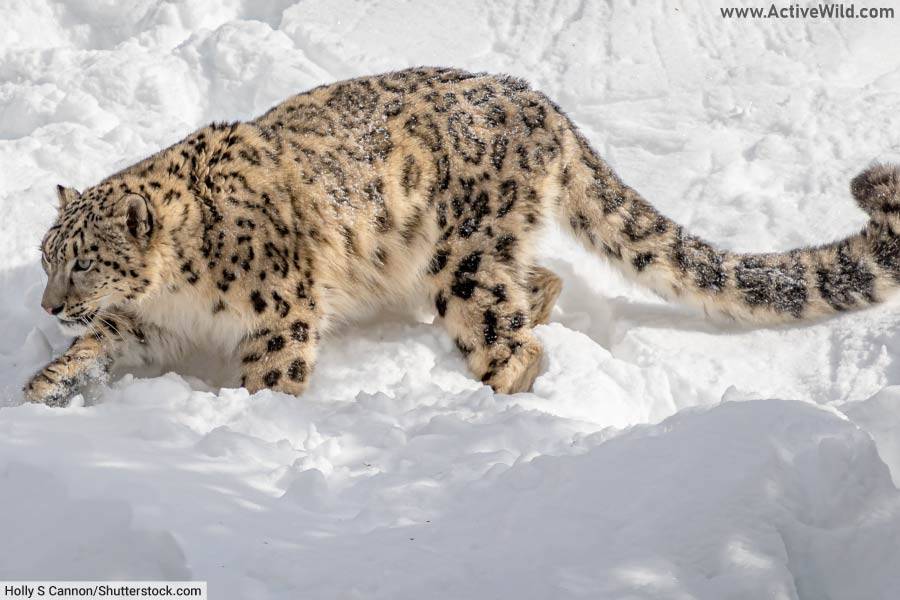
- Scientific name: Panthera uncia
- Type of animal: Mammal
- Family: Felidae
- Where found: Asia
- Conservation status: Vulnerable
The snow leopard is an elusive crepuscular* predator that can be found at elevations of 1,800 – 5,500 m / 5,905 – 18,044 feet. It prefers to live in rocky and steep mountains; coming across one in the wild is extremely rare.
* Active at dawn and dusk
Despite being a solitary and territorial apex predator, the snow leopard is not particularly aggressive and will usually leave a kill before engaging in confrontation with another individual.
The snow leopard, like all cats, is an obligate carnivore that needs to eat flesh in order to survive.
A nimble, yet powerful hunter, the snow leopard is capable of taking down prey up to four times its own weight.
This unique wild cat is still hunted by humans, even when the practice has been ruled illegal. Its fur is highly sought-after in the black market and its bones are used in traditional Asian medicine.
Discover More with Active Wild
You can find out more about snow leopards on this page: Snow Leopard Facts
You can see more Asian animals on this page: Asian Animals Pictures & Facts
You can see every wild cat species in the world on this page: Wild Cat Species Pictures & Facts
Sperm Whale
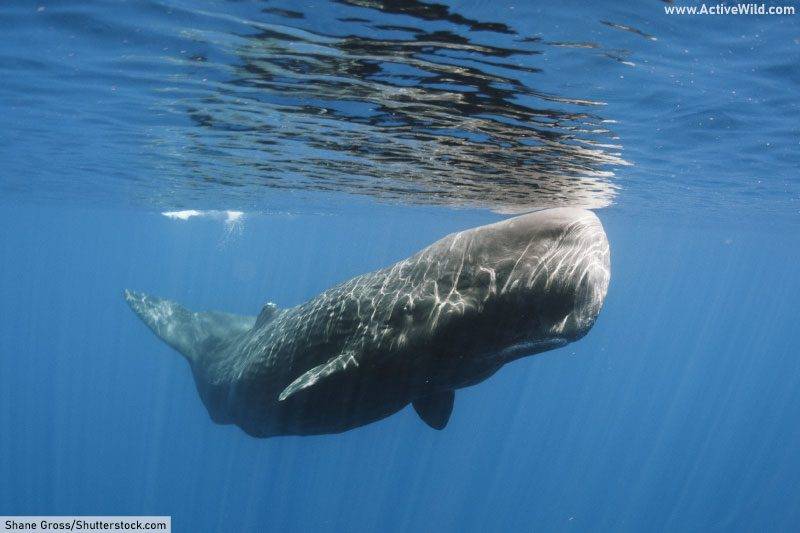
- Scientific name: Physeter macrocephalus
- Type of animal: Mammal
- Family: Physeteridae
- Where found: Oceans worldwide
- Conservation status: Vulnerable
The sperm whale is the largest species of toothed whale. An adult male reaches lengths of around 16 m / 52.5 feet and can easily weigh 45 tons / 92,208 lbs. This whale consumes 3.5% of its body weight in food every day!
The lower jaw of the sperm whale is lined with large conical teeth that weigh about 1 kg / 2.2 lb. each. Its brain weighs 9 kg / 19.8lb, making it the largest brain of all animals. The species can live for more than 60 years.
The sperm whale can hold its breath for up to an hour, and dives to depths of around 3,000 m / 9,842 feet to hunt its prey. Its diet consists mainly of squid, sharks, rays and fish.
Discover More with Active Wild
Discover more whales on this page: The World’s Biggest Whales
Find out why whales are mammals on this page: Are Whales Mammals?
You can see more amazing ocean animals on this page: Ocean Animals Pictures & Facts
Spotted Hyena
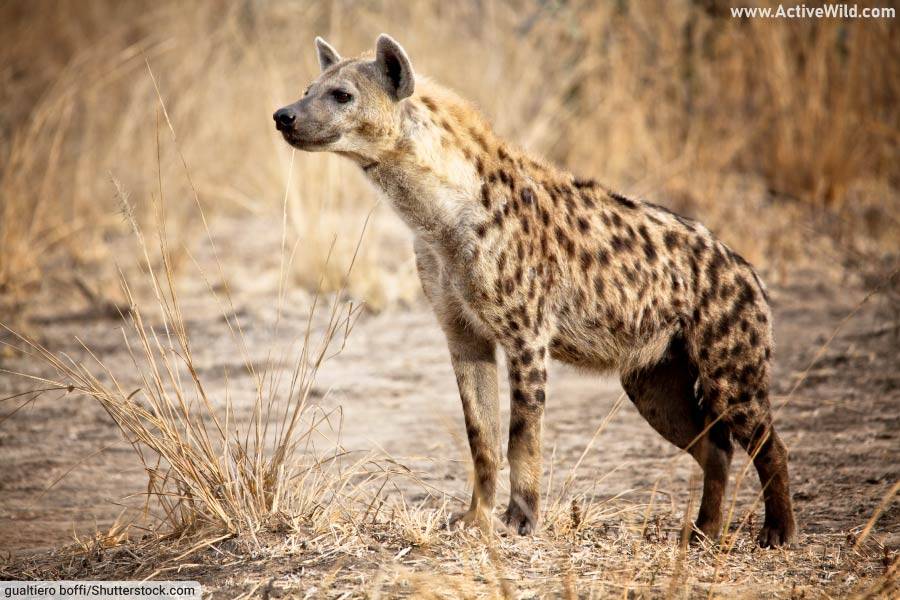
- Scientific name: Crocuta crocuta
- Type of animal: Mammal
- Family: Hyaenidae
- Where found: Africa
- Conservation status: Least Concern
The spotted hyena is a social creature that lives and hunts in groups known as “clans”, which contain anywhere between 3 and 80 members. The species is the largest member of the Hyaenidae family and the only one that makes the distinctive “laughing” sound.
Hyenas as a group have a reputation for being scavengers. While this is true for the brown and striped hyena species, the spotted hyena is an active apex predator that relies mainly on hunting rather than scavenging. Recent studies have found that around 70% of the species’ diet comes from direct kills.
Occasionally, a hyena may hunt on its own, but usually the species hunts in packs, using their numbers to capture and bring down large prey.
A hyena clan will compete against another clan for a kill and sometimes even steal food from a lion pride.
Male hyenas leave the clan upon reaching sexual maturity, whereas female hyenas remain in their birth clans for life.
Discover More with Active Wild
You can find out more about spotted hyenas on this page: Spotted Hyena Facts
Discover more African animals on this page: African Animals List with Pictures & Facts
Tiger

- Scientific name: Panthera tigris
- Type of animal: Mammal
- Family: Felidae
- Where found: Asia
- Conservation status: Endangered
The tiger is the largest member of the Felidae family and one of the world’s best-known animals due to its distinctive orange coat and black stripes.
This big cat is a solitary creature that will only socialize when mating. The female raises the cubs alone and cares for them from birth until they’re around 3 years old. During this time, she has to become an extremely efficient hunter as her killing rate must increase by around 50% in order to feed herself and her offspring.
The tiger is an excellent swimmer and will swim across rivers that can be several km / miles wide with great ease when looking for prey.
Although the tiger is an apex predator, its population continues to decline due to poaching for the illegal trade of its fur and other body parts.
Discover More with Active Wild
You can find out more about tigers on this page: Tiger Facts
You can see every wild cat species in the world on this page: Wild Cat Species Pictures & Facts
You can see more Asian animals on this page: Asian Animals Pictures & Facts
Wedge-Tailed Eagle
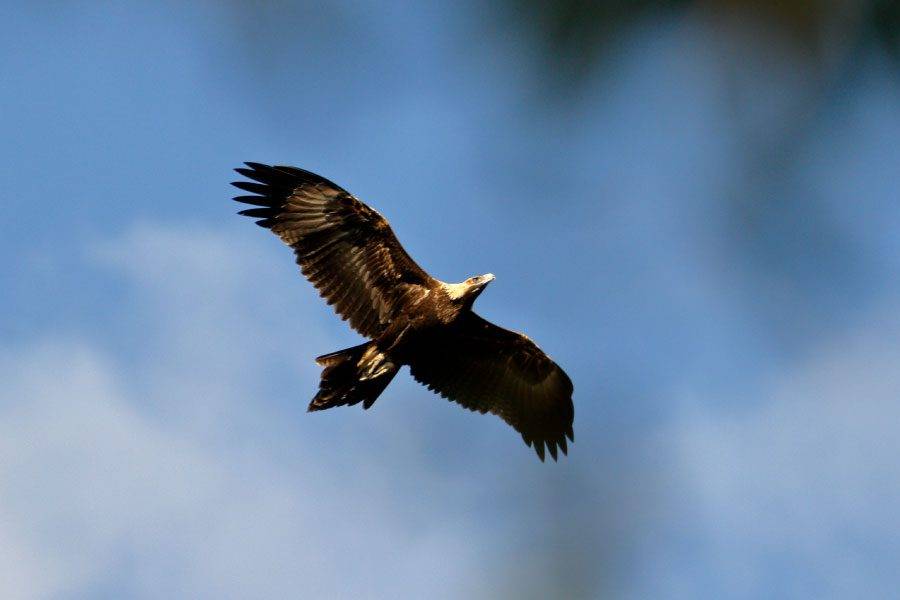
- Scientific name: Aquila audax
- Type of animal: Bird
- Family: Accipitridae
- Where found: Australia
- Conservation status: Least Concern
The wedge-tailed eagle is the largest bird of prey in Australia, reaching a weight of 5.3 kg / 11.7 lbs.
As is the case with most birds of prey, the female is larger than the male. Both sexes have dark brown plumage.
Found throughout Australia (including Tasmania) and also in southern New Guinea, the wedge-tailed eagle inhabits a variety of habitats, ranging from semi-deserts to rainforests.
As an adult, the wedge-tailed eagle has no natural predators. Eggs and hatchlings are preyed upon by several animals, in particular by monitor lizards.
The wedge-tailed eagle is monogamous. A bonded pair will not socialize with other conspecifics besides its young.
This diurnal carnivore plays an extremely important part in maintaining a healthy ecosystem, not least because the European rabbit, an invasive species in Australia, a staple of its diet.
Discover More with Active Wild
Discover more amazing Australian animals on this page: Australian Animals Pictures & Facts
Discover more about birds on this page: Birds – The Ultimate Guide
You can find out more about the different types of birds on this page: Types Of Birds Pictures & Facts
Wolf
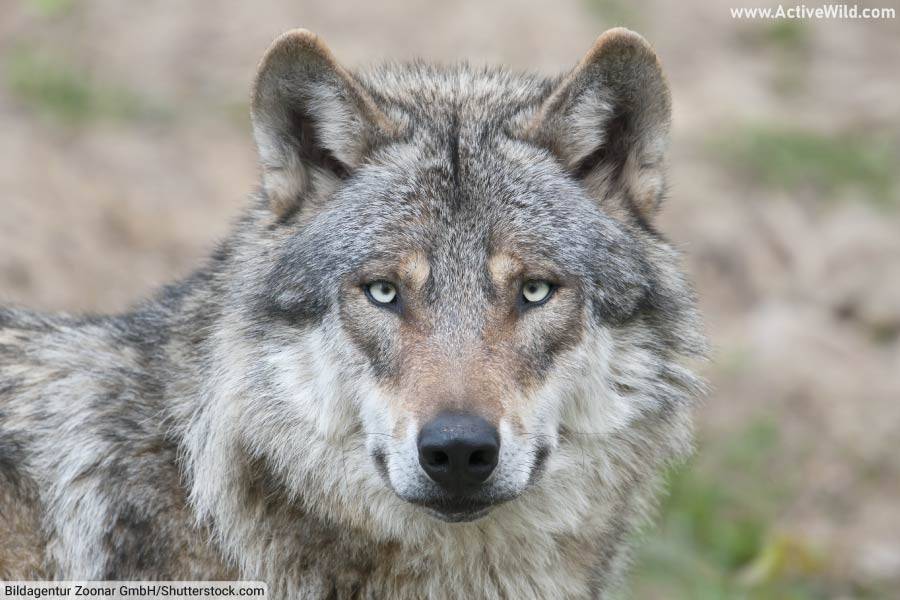
- Scientific name: Canis lupus
- Type of animal: Mammal
- Family: Canidae
- Where found: North America, Europe, Asia
- Conservation status: Least Concern
No list of apex predators would be complete without the wolf, one of the world’s best-known animals and one found in the folklore of peoples in many different parts of the world.
The wolf is the largest member of the Canidae family (excluding some breeds of domestic dogs). The male weighs around 80 kg / 176.4 lbs. while the female reaches 55 kg / 121.3 lbs.
This carnivore hunts both alone and in packs. It can run at speeds of 61.2 km / 38 miles an hour in short bursts while chasing prey. It is highly opportunistic and will feed on carrion when given the chance.
The wolf is a highly social animal and lives in “packs”, which usually comprise of a nuclear family. All members of the pack protect and care for the pups.
The wolf uses its acute sense of smell to locate prey. Most of the wolf’s diet is made up by large ungulates (hooved animals).
Discover More with Active Wild
You can find out more about wolves on this page: Wolf Facts
You can see every dog species on this page: Dog Species List with Pictures & Facts
You can see more iconic North American animals on this page: North American Animals Pictures & Facts
This list of apex predators contains just a small selection of the world’s top predators; there are many more. If you have any questions on: apex predators, the animals on this list, food chains, or anything else regarding the information on this page, then feel free to ask us in the comments section below!
The post Apex Predators List, Pictures & Facts: The Most Amazing Top Predators appeared first on Active Wild.